Cloud storage is great for both individual use like storing all of your photos and videos online, and for business use. If you’re working from home, storing your documents and sharing them with your team members over the internet is essential. When you keep your important files in the cloud, you also get the benefit of being able to access them at any time and place.
Both Box and Dropbox are excellent cloud storage clients that offer a lot to their users. Let’s explore the pros and cons of Box vs. Dropbox and see which one is right for you.
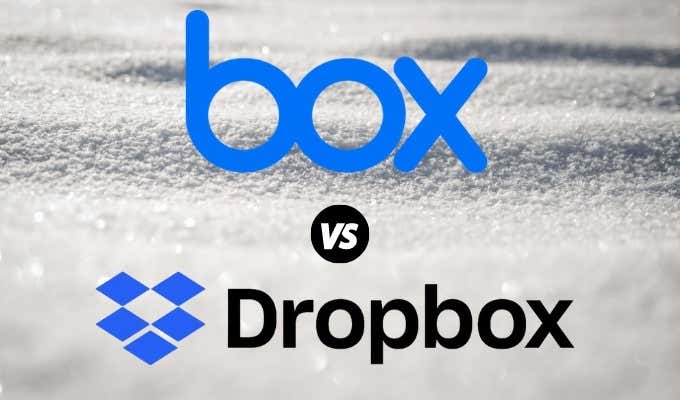
Box
Best for: business use, thanks to the variety of business-oriented subscription plans and a large number of integration options.
Pros:
- 10 GB free storage with a free personal account
- Easy to use interface
- Third-party apps integration
- You can create an account without sharing your billing information
Cons:
- Paid accounts are much more expensive compared to other cloud storage services
- 250 MB file upload limit with a free personal account
- The variety of desktop and mobile apps for different purposes can be confusing
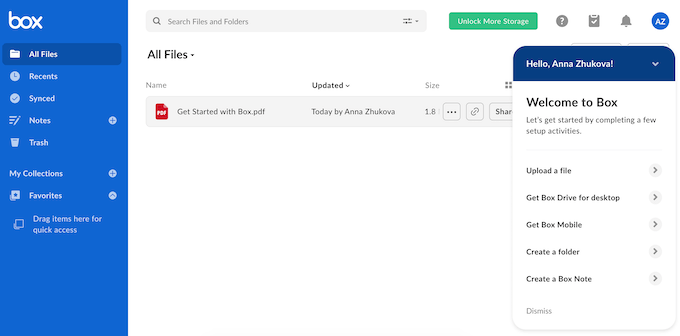
Box is an online cloud storage client that’s easy to use and has a clean beginner-friendly interface. Unlike other storage services, Box’s website allows you to do more with your files than just see, download, and share them.
Collaboration
You can create new documents right on the site, move your files around, create new folders, notes, and bookmarks. You can also work with your documents in Box using its web-based text editor Box Notes.

Aside from its native solution such as Box Notes, Box offers integration with a huge amount of third-party productivity apps that can improve your workflow and save your time. For example, Box integrates with Google’s office suite, Office 365, Trello, and Asana. You can also easily use tools that help you sign documents online like DocuSign and Adobe Sign with Box.
Desktop & Mobile Apps
Box desktop & mobile apps are where it can get confusing. There’s a variety of apps that you can find on the official Box Downloads page. They include Box Notes that we mentioned above – a text editor for your documents, Box Tools – a desktop app for editing other file types, like Office, CAD, and Photoshop, Box Drive – a desktop Box client for quickly accessing your synced, and Box App – an app for accessing and sharing your files from your smartphone.
The Box app offers a few unique features, like an ability to add a password to keep your files safe, and an auto-upload feature that allows you to automatically backup all of the photos and videos that you take on your smartphone in the cloud.
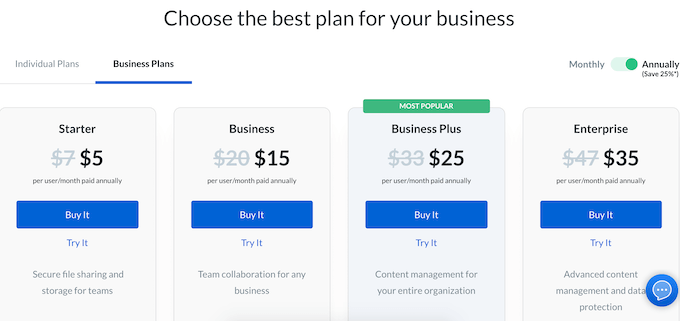
Pricing
Box has a variety of business-oriented plans, starting only at $5 per user per month for a Starter subscription plan. Most of these plans offer unlimited storage, unlimited number of external collaborators, and data loss protection. The most expensive Box package that offers unlimited storage space costs $35 per user per month.
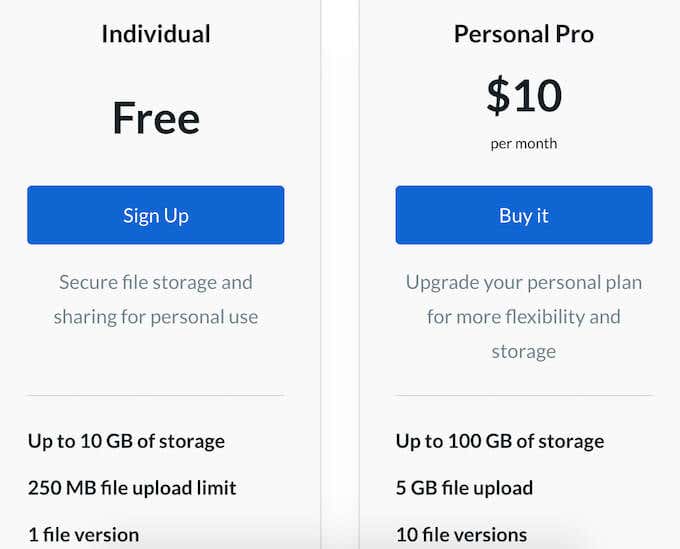
You can also get one of the Box’s individual use plans. The free subscription plan comes with 10 GB of free storage and all of the standard features, and the Personal Pro package offers up to 100 GB of storage and costs per month.
Dropbox
Best for: everyday use, as it’s compatible with almost every other app that you’re using.
Pros:
- A variety of useful native tools – Dropbox Paper, Showcase, HelloSign
- Separate apps for every device free to download
- Compatible with a large number of apps and services
Cons:
- Expensive paid subscription plans
- The free plan comes with only 2 GB storage
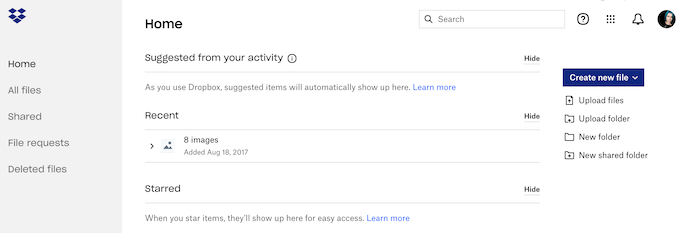
Dropbox is a pioneer cloud storage service that is still the #1 choice for many users. It’s a simple, user-friendly, and reliable file-sharing client that comes with built-in tools like Paper, Showcase, and HelloSign for working with your documents without leaving Dropbox.
Collaboration
All of those tools are meant for collaboration. Dropbox Paper is a tool that you can use to create new documents right inside the Dropbox web app and allow other users to add photos, videos, emojis to them, as well as comment on any part of your document.
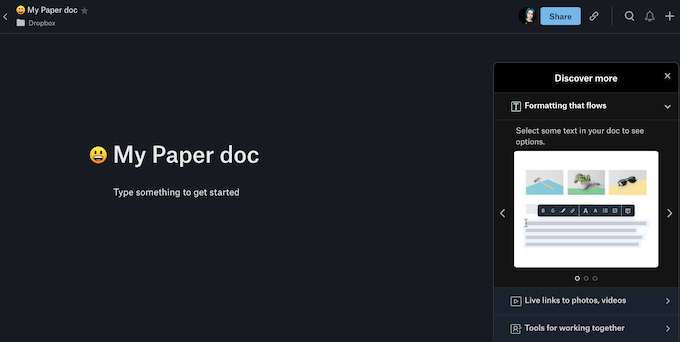
Showcase is a feature available for those with professional Dropbox accounts that allows you to present your documents to other users and then track who’s viewed or downloaded them.
Finally, HelloSign is a digital signature feature that allows you to sign your documents in Dropbox, as well as request electronic signatures from other Dropbox users.
Desktop & Mobile Apps
Dropbox has separate apps for pretty much any platform, including Windows, Mac, Linux, Android, iPhone, iPad, Kindle, and Windows tablets. You can also just use the web client without having to install anything.
If you do choose to install Dropbox on your computer, you’ll be pleasantly surprised at the low impact of the app on your operating system. Unlike other cloud services, Dropbox doesn’t have a full app interface on the desktop and appears as a little icon in your Mac’s ribbon menu instead.
Pricing
Whether you’re an individual only looking to store your personal files, or a team of professionals looking to share and exchange documents on a daily basis, Dropbox has a subscription plan that will suit your needs. While all Dropbox apps are free to download, the free storage is limited to just 2 GB.
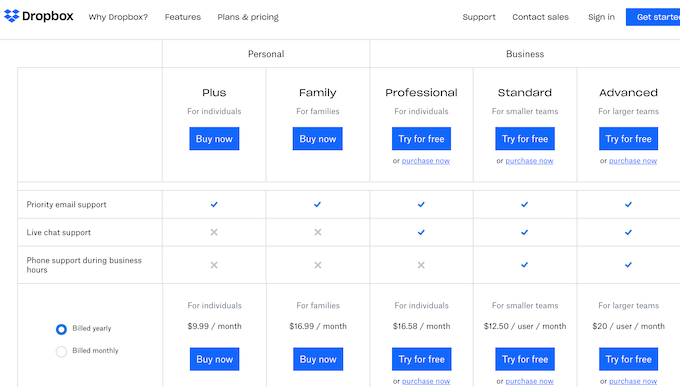
With a paid account, you can get from 2 TB to unlimited storage depending on the plan you choose. There are two tiers for personal use – individual ($9.99 per month) and a family plan ($16.99 per month), and three tiers for professional use starting at $16.58 per month. The subscription plan that offers unlimited storage space is the Dropbox Business Advanced and costs $20 per user per month if billed annually.
Which Cloud Storage Is the Best Pick for You?
Both Box and Dropbox offer great features and tools for storing and sharing your files online. While Box seems to be more business-oriented with a large number of subscription plan options for professionals, Dropbox might be a better bang for your buck if you’re planning to use it for personal needs.
If you want to compare these two cloud storage clients with other services, check out our comparison of Dropbox and Google Drive.
Have you used Box or Dropbox before? Which cloud storage app would you choose for yourself? Share your experience with cloud storage services in the comments below.